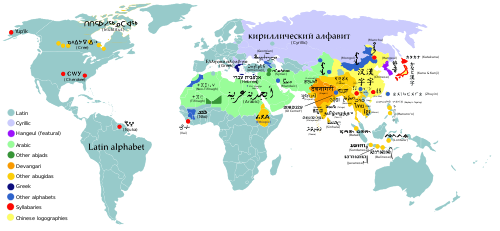EOTO: On Language as a Tool

First, we’ll
start off with Abjads. An abjad is a writing system that only represents
consonants in the script. Vowels are therefore inferred by the reader.
Interestingly enough, the most common and famous use of abjad is the Arabic
script. There are also things called “Impure abjads” where diacritic marks
(small symbols near a consonant) help imply the vowel. So many modern abjads
today, including Arabic, Hebrew, etc. include these diacritic marks (I will
touch on this again soon). Although Arabic is the most famous, one of the most
unknown to many people is the Phoenician abjad (Phoenician gives us the word “phonetics”
when talking about sound). The Phoenicians spread their idea of an abjad
writing system to the Greeks which gave us the “Alphabet.”
The
Alphabet comes from the first two characters in the Greek alphabet, “Alpha” and
“Beta,” although really it would’ve been pronounced Alphaveeta. It is
semi-debated by those who study linguistics how Greeks properly pronounced
their words. There are many theories, but there is an idea called betacism
wherein language, the /b/ sound can change and or will be confused for a /v/
sound. This is because both these sounds are pronounced in nearly the same
place in the mouth. But the Greek alpha-vet became so influential that the
Romans adopted it (and of course made changes) in Latin, as well as the
Cyrillic script used by Russia and other Slavic countries.
The Abugida
is a writing system that represents every consonant-vowel-paring. Sounds like /bi/
or /mai/ are represented with a base glyph, being the consonant’s symbol, and
connected somewhere to the glyph is a diacritic mark for the vowel sound. The
most famous abugida we know about is Devanagari, the alphabet used in the Hindi
language. This comes from Sanskrit, the language of ancient India, where the script
was adapted over time and became widespread. Most of us are familiar with the
symbol /Om/ spelled like ॐ. This is known as a sacred symbol in Indian
religions which stands for ultimate consciousness basically.
Syllabaries are like abugidas in some sense that they
represent consonants and vowels, but the main difference being: In an abugida,
if there is a sound starting with /b/, then the base glyph for /b/ will be used
and the diacritic will be marked around or onto it in every CV pairing. As for
a syllabary, even if two sounds start with a /b/ but have a different vowel
after the consonant, these vowels are bound to be quite different. Think of Japanese
for example.
Lastly, Logographies. This system has a separate
symbol for every grammatical word in a sentence. These can become very
intricate and detailed when written. The most famous use is Chinese. Another
example is the Aztec and Mayan writing systems which were famous for being
rounded and blocky.
In this video, by Artifexian he goes over the many different styles of writing systems used in history. He also goes more into the aesthetic of the characters including the medium in which writing was used, languages that use these writing systems, and even presents ideas for how a fictional language could formulate a realistic writing system.

Ethan, this is really fascinating history. Thank you! I had to Google a few of the terms you used to learn more. Keep going!
ReplyDelete